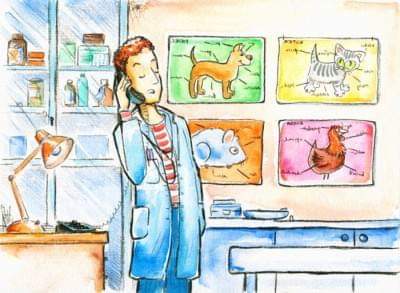by-DR RAJESH KUMAR SINGH, JAMSHEDPUR, JHARKHAND,INDIA
9431309542,rajeshsinghvet@gmail.com
Technology of telemedicine: —–
Telemedicine is a technology that allows a veterinarian to digitalize radiographic, ultrasound and microscopic images and send them via fax or the internet to a veterinary specialist for interpretation providing service without leaving their veterinary dispensary/hospital. Veterinary cardiologists, radiologists, dentists, ophthalmologists, dermatologists, surgeons, and internal medicine specialists are now accessible by telemedicine. While tele-electrocardiography has been around since the 1980s, teleultrasonography, teleradiology and telecytology appears to be the most commonly practiced and viable forms of veterinary telemedicine
Telemedicine is a confluence of communication technology, information technology, biomedical engineering and medical science. Technology ranges from the basic telephone service to broadband internet that allows physicians, nurses and other allied health professionals to provide healthcare at a remote locations .Three things are necessary to achieve communication: a sender, receiver and a medium which will transmits information from a sender to a receiver. The telemedicine system consists of customized hardware and software at both the patient and specialist doctor ends, with some of the diagnostic equipments like ECG, X-ray, microscope/camera etc., provided at the patient end. Communication is made through a Very Small Aperture Terminal (VSAT) system and controlled by the network hub station of Indian Space Research Organization (ISRO) .Through a telemedicine system, medical images and other information relative to the patients could be sent to the specialist doctors, either after imaging or on a real time basis through the satellite link in the form of digital data packets. These packets are received at the specialist centre, the images and other information is reconstructed so that the specialist doctor can study the data, perform diagnosis, interact with the patient, and suggest the appropriate treatment during a video conference with the patient end. Telemedicine facility thus enables the specialist doctor and the patient separated by thousands of kilometers to see each other, talk with each other, assessing the physical and psychological state of the patient and to suggest appropriate treatment. In this way, the systematic application of Information and Communication Technology (ICT) to the practice of health care rapidly expands the outreach of the health care system.
Telemedicine is a rapidly developing application of clinical medicine wherein medical information is transferred via telephone, the Internet or other social networking sites like facebook, watsaap, instagram etc networks for the purpose of consulting, and sometimes remote medical procedures or examinations. Telemedicine may be as simple as two health professionals discussing a case over the telephone, or as complex as using satellite technology and video-conferencing equipment to conduct a real-time consultation between medical specialists in two different countries. Telemedicine generally refers to the use of communications and information technologies for the delivery of clinical care.
Care at a distance (also called in absentia care), is an old practice which was often conducted via post; there has been a long and successful history of in absentia health care, which, thanks to modern communication technology, has metamorphosed into what we now know as modern telemedicine.
The terms e-health and tele-health are at times wrongly interchanged with telemedicine. Like the terms “medicine” and “health care”, telemedicine often refers only to the provision of clinical services while the term tele-health can refer to clinical and non-clinical services such as medical education, administration, and research. The term e-health is often, particularly in the UK and Europe, used as an umbrella term that includes tele-health, electronic medical records, and other components of health IT.
Telemedicine has also picked up in veterinary practice and many private entrepreneurs have jumped into it as service providers. In the Indian context, asynchronous telemedicine involving sending of case details and images/lab reports via e-mail to experts for a second opinion is gaining ground. Real-time telemedicine involving text/video chats with the experts has also become more feasible with the availability of broadband internet connections in rural areas also. Standardized systems need to be developed for the transmission of data like case history, ECG, ultrasound, radiograph, laboratory test reports etc. in order to minimize errors due to mis-communication. Creation of a website where field vets can upload their case details in a standard format and experts from Veterinary Colleges or anywhere across the globe can give their opinion would go a long way towards disseminating information on complicated cases and ensuring best possible veterinary care. Data collected on such a website over a period of time, including interventions carried out and the resultant effect, would help in evaluation of various therapeutic strategies and serve as a guideline for future reference.
Veterinary telemedicine is a technology whose time has come and we must adopt it with open arms in order to ensure that two-way flow of information is facilitated between field veterinarians and subject experts, thus resulting in an enriching experience for animal husbandry sector.
Types of Telemedicine—–
Telemedicine is practiced on the basis of two concepts: Synchronous and Asynchronous.
• Synchronous or Real-time telemedicine : —-
This could be as simple as a telephone call or as complex as robotic surgery. It requires the presence of both parties at the same time and a communication link between them that allows a real-time interaction to take place. Video-conferencing equipment is one of the most common forms of technologies used in synchronous telemedicine. There are also peripheral devices which can be attached to computers or the video-conferencing equipment which can aid in an interactive examination. For instance, a tele-otoscope allows a remote physician to ‘see’ inside a patient’s ear; a tele-stethoscope allows the consulting remote physician to hear the patient’s heartbeat. Video conferencing has been successfully inducted as a mode of distance learning for veterinary students as well as practicing veterinarians at the many College of Veterinary colleges of our country.
• Asynchronous or Store-and-forward telemedicine—–
involves acquiring medical data (like medical images, bio-signals etc) and then transmitting this data to a doctor or medical specialist at a convenient time for assessment offline. It does not require the presence of both parties at the same time. A properly structured Medical Record preferably in electronic form should be a component of this transfer. Laboratory diagnosis by radiologists or pathologists extensively depends on this method.
Telemedicine is most beneficial for populations living in isolated communities and remote regions and is currently being applied in virtually all medical domains. Specialties that use telemedicine often use a “tele-” prefix; for example, telemedicine as applied by radiologists is called tele-radiology. Similarly telemedicine as applied by cardiologists is termed as tele-cardiology etc. Telemedicine is also useful as a communication tool between a general practitioner and a specialist available at a remote location.
The first interactive Telemedicine system, operating over standard telephone lines, for remotely diagnosing and treating patients in cardiac arrest (defibrillation) was developed and marketed by MedPhone Corporation in 1989. A year later, the company introduced a mobile cellular version, the MDPhone. Twelve hospitals in the U.S. served as receiving and treatment centers.
Monitoring a patient at home using known devices like blood pressure monitors and transferring the information to a caregiver is a fast growing emerging service. These remote monitoring solutions have a focus on current high morbidity chronic diseases and are mainly deployed for the First World. In developing countries a new way of practicing telemedicine is emerging better known as Primary Remote Diagnostic Visits whereby a doctor uses devices to remotely examine and treat a patient. This new technology and principle of practicing medicine holds big promises to solving major health care delivery problems.
Tele-Radiology——-
Tele-radiology is the ability to send radiographic images (x-rays) from one location to another. For this process to be implemented, three essential components are required, an image sending station, a transmission network, and a receiving / image review station. The most typical implementation is two computers connected via Internet. The computer at the receiving end will need to have a high-quality display screen that has been tested and cleared for clinical purposes. Sometimes the receiving computer will have a printer so that images can be printed for convenience. The tele-radiology process begins at the image sending station. The radiographic image and a modem or other connections are required for this first step. The image is scanned and then sent via the network connection to the receiving computer.
Advantages of telemedicine technology:—–
Telemedicine is advantageous to the patients, health care professionals, and society in many different ways. Telemedicine facilitate timely access to locally unavailable services enabling delivery of health care benefits to patients suffering from serious conditions or diseases. It speeds up the medical research and innovations by allowing health care professionals to share their findings from any location. It spares burden and cost of unnecessary travel of the patients thus limiting patient exposure to infections by eliminating or limiting the need of visit to a hospital for health care services. To the society telemedicine benefits through critical care monitoring when it is not possible to transfer the animals and by providing veterinarian expertise to livestock at remote locations. Most importantly medical records are digitalized enabling universal and, permanent availability at any time of age allowing continuity in treatment and reducing the incidence of adverse events or medication errors. Telemedicine allows local communication between scientists, researchers, field veterinarians and, private practioners allowing update with recent advancements in veterinary science at any time and learning vice-versa. Telemedicine could also be able to be used to overcome shortages of veterinarians in some areas, deliver education and facilitate research. Mobile internet applications are also helpful in telemedicine and gaining popularity making it possible that minor health problems can be solved at a distance also. Many professional groups are created on social networking sites like facebook where veterinarians are sharing and discussing their technical knowledge adding some dimensions to primitive type of telemedicine
Need of initiative of telemedicine in veterinary practice:——
The veterinary and animal husbandry are highly specialized area involving management and health care of varied species of animals, disease diagnosis, treatment and prevention of the diseases, quality assessment of meat and food including milk and milk products, quarantine procedures, animal welfare, feed formulation and testing, dissemination of technologies, besides teaching, training, innovation, generation and transfer of knowledge or technologies for end users as well as for administrators. The role of veterinarians has, thus, become versatile as a clinician, educator, researcher, extension educator, research administrator, consultant, policy maker and advisor demanding much more workforce in scarcity of time as well as resources. In India there are approximately 9527 veterinary hospitals/polyclinics, 20,897 veterinary dispensaries, 24482 veterinary aid centers and 67,048 artificial insemination centers offering quality veterinary services. But there is a huge gap, the requirement of 67,000 veterinarians is fulfilled only by the available 34,500 veterinarians. Against the requirement of 7500 veterinary and animal science specialists for teaching and research, only 3050 are available to manage universities and colleges (Planning commission working body report, 2014). Shortage of work force and inadequacy of veterinary infrastructure arouses the need of telemedicine as future of animal health care services in India

Potential scope under telemedicine ——
1. Teledermatology: Images of skin lesions/skin parasites transferred electronically for proper diagnosis of skin infections/diseases. 2. Teleophthalmology: It includes remote screening of cases of cataract, glaucoma and diabetic retinopathy. 3. Telecardiology: Important to remotely diagnose, treat and manage cardiac diseases through echocardiograms, angiograms and, blood pressure monitoring. 4. Telepathology: It refers to process of diagnostic pathology performed on digital images viewed on a display screen rather than by conventional light microscopy with glass slides. A Telepathology image sent through electronic mail provides acceptable efficacy and a quicker turnaround time than post and can be applied to veterinary diagnostic cytology. 5. Teleradiology: Teleradiology is considered as a paradigm for other applications owing to long history of use. Patient’s radiographic/pathologic images and consultative texts are electronically transmitted from one medical location to another. 6. Telesurgery: A particular advantage of this type of work is that the surgeon can perform many more operations of a similar type and with lesser fatigue.
Specific veterinary telemedicine applications have been in use since the early 1980s, but little study about its efficacy and validity has been undertaken in this field. The demanding quality health services in animal health care sector, coupled with an expected shortage of expertise, over the coming decades accentuates the need for veterinary telemedicine. Awareness among livestock owners and stack holders is essential to accept this emerging technology as a facilitator for quality healthcare delivery especially in rural areas. Ethical and legal issues around the practice of veterinary telemedicine, image standards, the equipment that is required for the practice of telemedicine, advice on ways in which digital images can be obtained, standardization of various systems, including the system for payment and educational aspects are the regulatory issues which need to be resolved. Policy making bodies need to plan the implementation of policies for the use of veterinary telemedicine besides developing revenue models and creating infrastructure for meeting the need of training manpower and carrying out research and development. In India with current bloomed IT sector, veterinary telemedicine is a technology whose golden era has arrived and government/agricultural universities must adopt it with open arms in order to ensure that two way flow of information is facilitated between field veterinarians and subject experts, thus resulting in an enriching experience for both, also providing more quality services to animal health care sector.



